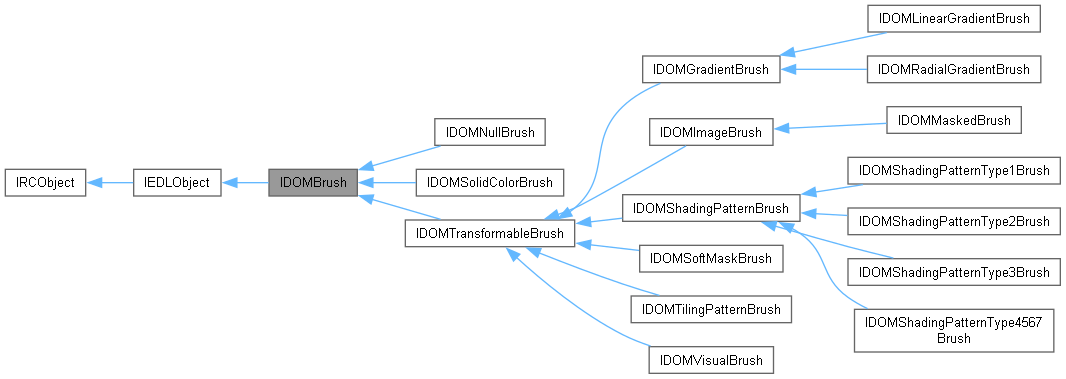Interface to the brush element. More...
#include <idombrush.h>

Public Types | |
| enum | eBrushType { eSolidColor , eLinearGradient , eRadialGradient , eImage , eMasked , eVisual , eSoftMask , eTilingPattern , eType1ShadingPattern , eType2ShadingPattern , eType3ShadingPattern , eType4567ShadingPattern , eNull } |
| Brush type enumeration. More... | |
Public Member Functions | |
| virtual eBrushType | getBrushType () const =0 |
| Retrieves the type of the brush. | |
| virtual float | getOpacity () const =0 |
| Retrieves the opacity value of the brush element. | |
| virtual void | setOpacity (float opc)=0 |
| Sets the opacity value of a brush element. | |
| virtual IDOMBrushPtr | getAdjustedForUseInTransformedNode (IEDLClassFactory *pFactory, const FMatrix &nodeTransform) |
| Get a version of this brush adjusted for use inside a node with the given transform. | |
 Public Member Functions inherited from IEDLObject Public Member Functions inherited from IEDLObject | |
| virtual const CClassID & | getClassID () const =0 |
| Returns class ID of IEDLObject. | |
| virtual bool | init (CClassParams *pData) |
| The init() method is called to perform any post-construction initialization of an IEDLObject that has been created by the EDL class factory, before it is actually returned by the factory. | |
| virtual bool | clone (IEDLObjectPtr &ptrObject, IEDLClassFactory *pFactory) |
| Create a copy of EDLObject. | |
 Public Member Functions inherited from IRCObject Public Member Functions inherited from IRCObject | |
| virtual void | addRef () const =0 |
| Increases the reference count of the actual object pointed to. This would take place during an assignment or copying. | |
| virtual bool | decRef () const =0 |
| Decreases the reference count of the actual object pointed to. When the reference count falls to Zero, it deletes the actual object pointed to. | |
| virtual int32 | getRefCount () const =0 |
| Retrieve the current reference count of the actual object pointed to. | |
Additional Inherited Members | |
 Protected Member Functions inherited from IRCObject Protected Member Functions inherited from IRCObject | |
| virtual | ~IRCObject () |
| Virtual destructor. | |
Interface to the brush element.
Brushes are used to paint the interior of the geometric shapes defined by a Path and the characters rendered by a Glyphs node. They are also used to define the alpha-transparency mask in the IDOMCanvas::OpacityMask, IDOMPathNode::OpacityMask, and IDOMGlyphs::OpacityMask properties.
All brushes are defined relative to a coordinate space. Most brushes (including image brushes, visual brushes, linear gradient brushes, and radial gradient brushes) may specify a coordinate space transform, in which the transform property is concatenated with the current effective coordinate space to yield an effective coordinate space local to the brush. For image brushes and visual brushes, the viewport is transformed using the local effective render transform. For linear gradient brushes, the start point and end point are transformed. For radial gradient brushes, the center, x-radius, y-radius, and gradient origin are transformed.
If there is an alpha component of the color, it is combined in a muliplicative way with the opacity value.
|
virtual |
Get a version of this brush adjusted for use inside a node with the given transform.
That is, it adjusts the transform by post-multiplying the render transform with the inverse of the given transform.
If the brush is not transformable, or if the transform is degenerate (where the matrix of the brush is irrelevant), then the original brush will be returned.
This will also adjust the sub-brush, if this is a masked brush.
| pFactory | The factory to use. |
| nodeTransform | The transform of the node in question. |
|
pure virtual |
Retrieves the type of the brush.
|
pure virtual |
Retrieves the opacity value of the brush element.
The opacity value defines the uniform transparency of the canvas. This is a number between 0 (fully transparent) and 1 (fully opaque). Default value 1.0
|
pure virtual |
Sets the opacity value of a brush element.
| opc | The opacity value |